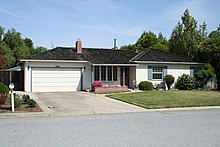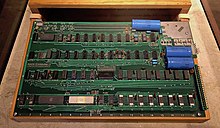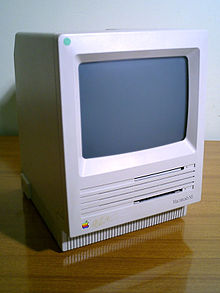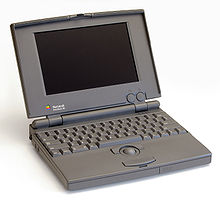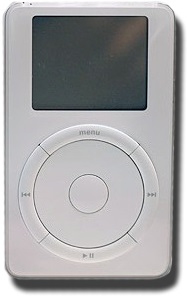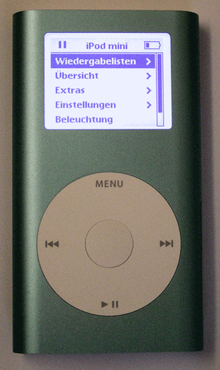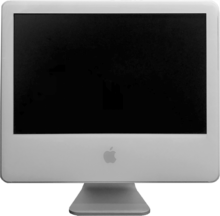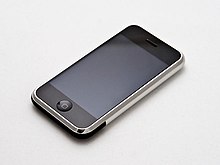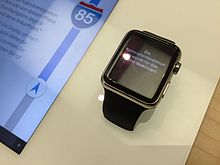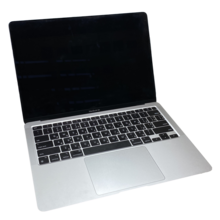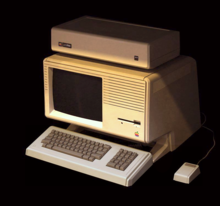History of Apple Inc.
[11][12] Their first business partnership began in the fall of that year when Wozniak, a self-educated electronics engineer, read an article in Esquire magazine that described a device that could place free long-distance phone calls by emitting specific tone chirps.
Wozniak started to build his original “blue boxes”, which he tested by calling the Vatican City pretending to be Henry Kissinger wanting to speak to the pope.
In his essay From Satori to Silicon Valley (published 1986), cultural historian Theodore Roszak made the point that Apple Computer emerged from within the West Coast counterculture and the need to produce print-outs, letter labels, and databases.
[17] Initially, Wozniak intended to share schematics of the machine for free, but Jobs insisted that they should instead build and sell bare printed circuit boards for the computer.
[20] In order to raise the money they needed to produce the first batch of printed circuit boards, Jobs sold his Volkswagen Type 2 minibus for $1,500, and Wozniak his HP-65 programmable calculator for $500.
[29] Jobs told Walter Isaacson that he was "on one of my fruitarian diets," when he conceived of the name and thought "it sounded fun, spirited and not intimidating ... plus, it would get us ahead of Atari in the phone book.
[31] Paul Terrell, who operated the computer store chain Byte Shop, was impressed,[27] and gave the two Steves his card, asking them to keep in touch.
If you give me the parts on net 30-day terms I can build and deliver the computers in that time frame, collect my money from Terrell at the Byte Shop and pay you.
Jobs looked for investments to expand the business,[38] but banks were reluctant to lend him money; the idea of a computer for ordinary people seemed absurd at the time.
[46] In February 1977, Markkula recruited Michael Scott from National Semiconductor to serve as the first president and CEO of Apple Computer, as the two Steves were both insufficiently experienced and he was not interested in taking that position himself.
During the development of the Apple II, Jobs pressed for a well-designed plastic case and built-in keyboard, with the idea that the machine should be fully packaged and ready to run out of the box.
[55] So important that the Apple II became what John Markoff described as a "VisiCalc accessory",[57] the application created a business market for the computer and gave home users an additional reason to buy it: compatibility with the office.
[66] The Apple III was a conservative design for the era, however Jobs wanted the heat generated by the electronics to be dissipated through the chassis of the machine rather than by the more usual cooling fan.
By August 1981 Apple was among the three largest microcomputer companies, perhaps having replaced Radio Shack as the leader;[74] revenue in the first half of the year had already exceeded 1980's $118 million, and InfoWorld reported that lack of production capacity was constraining growth.
Simultaneously the Lisa group worked on a new machine that would feature a completely different interface and introduce the words mouse, icon, and desktop into the lexicon of the computing public.
On the same day, an emotional Jobs introduced the computer to a wildly enthusiastic audience at Apple's annual shareholders meeting held in the Flint Auditorium;[105][106] Macintosh engineer Andy Hertzfeld described the scene as "pandemonium".
[110][111] The Macintosh was based on The Lisa (and Xerox PARC's mouse-driven graphical user interface),[112][113] and it was widely acclaimed by the media with strong initial sales supporting it.
Wozniak guessed that Jobs first heard the news from an article in The Wall Street Journal where he mentioned that he wasn't leaving because he was disgruntled with Apple, but that he was excited to build a new remote control.
"[128]: 289 In April 1985, Sculley decided to remove Jobs as the general manager of the Macintosh division, and gained unanimous support from the Apple board of directors.
[145] In 1995, to achieve deeper market penetration and extra revenue, Apple officially began licensing the Mac OS and Macintosh ROMs to 3rd party manufacturers.
[146] Apple had market share of over 10% until Jobs was re-hired in 1997 as interim CEO to replace Gil Amelio, and found a loophole to terminate the Macintosh OS licensing program.
The long-standing dispute over whether Windows infringed Apple patents was settled,[157] and Internet Explorer would ship as the Macintosh's default browser, with the user able to have a preference.
Microsoft chairman Bill Gates appeared on-screen explaining plans for developing Mac software, and expressing excitement to be helping Apple return to success.
[161] Aimed at consumers and professionals alike, Mac OS X married the stability, reliability and security of Unix with the ease of a completely overhauled user interface.
This model dispensed with the base altogether, placing the CPU and the rest of the computing hardware behind the flat-panel screen, which is suspended from a streamlined aluminum foot.
Later additions in the London area include Brent Cross (January 2006), Westfield in Shepherd's Bush (September 2008), and Covent Garden (August 2010), which at 40,000 square feet (3,700 m2) was, as of 2015, the largest Apple Store in the world.
MobileMe, at the same US$99.00 annual subscription as its dotMac predecessor, featured "push" services to instantly and automatically send emails, contacts and calendar updates directly to users' iPhones.
[188] The Guardian reported that one of the reasons for the change was because PC software, where Microsoft dominates, has become less important compared to the tablet and smartphone markets, where Apple has a strong presence.
In October 2018, Bloomberg reported that, as early as 2015, a specialized unit of China's People's Liberation Army began inserting chips into Supermicro servers that allowed for backdoor access to them.
[214][215] Employees engaged in hashtag activism on social media inspired by the #MeToo movement called #AppleToo[216] and two American stores unionized for the first time.


